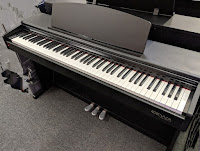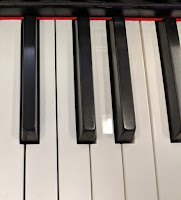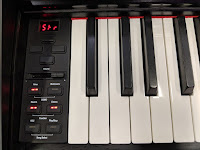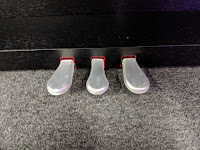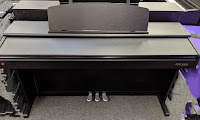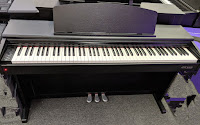REVIEW – Gewa DP200 / DP200G – Not Recommended – GEWA is a music instrument company in Germany and they manufacture digital pianos as well as orchestra & band musical instruments. Their digital pianos just recently started selling in the US in 2017 primarily through the Sam Ash Music company on-line and in the Sam Ash stores. Sam Ash is a fine music instrument retail company in the US and they sell a lot of nice digital pianos, but unfortunately this new DP200 (aka: DP200G) selling for $1199US internet discount price is not one of these good digital pianos. Although web site descriptions and specs of digital pianos may seem to make those pianos sound like incredible instruments, the specs do not always translate into the actual reality of that instrument. So it goes with the DP200 not being what it should be which is a digital piano that actually plays and sounds like a real piano. I have previously done a review of some higher priced GEWA digital pianos called UP260G and UP280G and even those digital pianos have issues which concern me and I don’t recommend those models either, although I wish I could. You can read my review of those higher price models at the following link: GEWA UP260G/UP280G Review
I will start off by saying I have nothing against the GEWA company as I believe they are a good company trying to make good instruments. But the outcome of the DP200 when playing the piano sound is just not good based on my experience with it. The main (but not only) issue I have with the DP200 is the piano sound response when you press down the keys to play music. On a real piano when you press down a key lightly you should get a softer volume, and when you continue to press the keys harder and harder, the volume of that note should increase smoothly and not be jumpy or inconsistent in volume while getting louder and louder. Then when you press the keys with even more strength wanting even more expression, the piano tone (mellow to bright as as you play harder on the keys) and the volume should increase smoothly with no uneven bumps or jumps. Also as you move up and down the keyboard with your fingers and play various black & white keys, the volume of each key should be approximately the same when striking the keys at the same velocity along with the sound of the piano notes being the same tonal quality and characteristics (more mellow, more bright, etc). With the GEWA DP200, the key touch volume starts out way too soft even when the master volume is all the up to maximum output so it’s difficult to hear. Then as you try to play the keys with more strength to bring in expression and louder volume, you really have to play abnormally hard on the keys to get that result and the volume does not transition smoothly but jumps up in volume and is erratic, especially when playing the keys a bit harder trying to get more volume to come out. Then when playing the keys more gently the volume of the notes almost disappears. This is definitely not how real pianos and most other digital pianos behave. The key volumes and tonal elements when playing the keys in a real piano and most good digital pianos are smooth and natural and are not jumpy or erratic.
The physical key action movement in the DP200 is actually pretty good in terms of the way it moves and it’s slightly lighter in touch than the key actions in higher priced GEWA models which are significantly firmer and heavier and not as enjoyable to play in my opinion. So I actually like the physical key movement and weight better in the DP200 than the UP260G and UP280G and overall it’s good in that way and a relatively quiet key action. Unfortunately the feel of the keys goes to waste in this model because of the key electronics for touch sensitivity volume and expression not being able to respond correctly to the movement of the keys which then creates these noticeable anomalies in the piano sound in terms of volume control and tone. It would be like you using your remote control for your TV volume and having the volume be jumpy going from loud to soft or soft to loud much too quickly when trying to adjust volume. This may not be the greatest analogy but that’s kind of the way these pianos behave; I just cannot play normally on the GEWA pianos and I have not had this issue before with any major brand of digital piano including Yamaha, Korg, Casio, Kawai, Roland, etc, although I have had similar experiences to the GEWA on other secondary digital piano brands like Suzuki and Williams. On the GEWA pianos some notes also come in noticeably louder than other notes when you first strike the key (at the same velocity) which is a different problem than the overall key volume issue I was just speaking about. Having one note come in louder than another note when playing with the same finger pressure on those keys is very annoying and not normal. Also when playing certain notes, especially in the middle octaves where most people play, the sound on some notes is noticeably brighter and sharper than the tone of other notes surrounding it which are noticeably more mellow. It’s like the notes were taken from two different pianos…and that would not be good. On top of all this, the volume of the non-acoustic piano sounds such as electric pianos, strings, etc come in at a super low volume when playing the keys fairly hard even if the maximum volume of the piano is all the way up. You can barely hear the instrument tones when playing them which just adds more and different weird volume issues to all of this, but this time on the non-piano sounds. As you can tell, I am not very happy about the piano playing experience on this model so far.
The internal speaker system is overall not very loud even with its 2×12 watt stereo amplification system and the piano sound itself is somewhat “boxy” or muffled inside the cabinet. When playing through headphones the sound coming out through a good pair of headphones is much brighter with more high frequency than through the internal speaker system which is good, but in fact almost a bit tinny sounding along with the overall headphone volume being a bit low. With regard to the volume coming out of the speakers or through headphones, like many other digital pianos GEWA has a digital adjustment feature in the control panel to change the touch velocity curve. However, if you change this feature from normal to light hoping that the piano sound would come in a bit louder when playing at a lighter touch, this does give a small improvement in that way but at the same time the overall piano sound also brightens up quite a bit and changes the tone of the piano in a way that some people may not like. So as far as I can tell there is just no good way to make improvements to the velocity touch curve in the way the piano come out when playing keys lightly and then hoping for smooth volume transitions when adding more expression to your music and increasing pressure on the keys…it’s just too uncontrollable and makes for a frustrating playing experience whether you are a beginner or more advanced player. It is certainly not enjoyable for me to play on this model and that’s a real shame because the actual piano sound itself has some enjoyable tonal characteristics to it and the piano sample itself is quite good. GEWA claims their “piano sound” comes directly from this ultra expensive Steinway concert grand piano and that my be the case as they claim, but the key touch electronics and other key mechanism traits renders this otherwise impressive piano sample…useless, as far as I am concerned.
The pedals on the GEWA work good and provide normal function like a real piano and the sustain decay time (how long it takes a note to fade out while the pedal is being held down) is very good when holding down the damper pedal. However, the pedals themselves are physically noisy when they go up & down and distract somewhat from piano playing so that’s an area which could use some improvement. Pedaling is very important when playing a piano and having the sound sustain for a good period of time is also important and overall the GEWA DP220 does a good job in this area with the exception of the pedaling noise although without good piano key volume transitions coming out of the piano when playing the keys at different velocities (soft to hard), then the pedaling is not as enjoyable.
The GEWA DP200 sounds like it has some impressive features when you look at the listed specs below of this model:
- Premium 88 Key Digital Piano
- Grand Piano Sampled from Steinway D274
- FATAR Graded Hammer Action Keybed
- Built in Stand with Pedal System and Speakers
- Enhanced with Quantum Memory IC for uninterrupted loop-free samples
- Dual Mode is ideal for student/teacher lessons
- 256 Note Polyphony
- 10 Total Sound Presets
- 4 Distinct Reverb settings
- USB Output
- Built in Recorder/Metronome
- Dual Headphone Outputs
There are 10 total instrument sounds (which is not very much so that’s a bit disappointing), 256 note polyphony which is actually very good and offers more than enough piano sound engine power for playing multiple notes at the same time, a very impressive acoustic grand piano from which the piano tone was taken, a nice physically smooth moving and relatively quiet key action, a basic MIDI recorder, a digital metronome, ability to layer/mix 2 sounds together and have a split setup with a different sound on the left hand and a different sound on the right hand, USB connectivity to external device, and a few other features along with a basic but useful LED small display screen with the control panel off to the left side of the keyboard. While the keyboard itself may feel pretty good in terms of physical movement, it is no way plays like a grand piano as some seller web sites may suggest, which at this price range it should not. But it’s fine for recreational piano playing and that’s what really counts. The key action is piano weighted and graded in the way it’s built and it also has triple key sensor design under the keys which would normally be good, although as I mentioned previously at length, there is a big disconnect between the physical nature of the keys and the piano sound that comes out when playing at different velocities on the keys….something is just really wrong with this model in the expression of the piano sound and similar things are found in the GEWA models above this one.
The cabinet design on the GEWA DP200 is fairly nice and looks more traditional in appearance which a lot of piano shoppers like. The cabinet weighs about 93 lbs so is fairly easy to move if necessary and the cabinet dimensions are approx 52″ long x 16″ deep x 30″ high. The cabinet color available in the US is only in black although GEWA offers matte Rosewood and matte white available in other countries. The DP220 cabinet has a nice back privacy panel on it along with the piano having a sliding key cover. The pedals are chrome/nickel plated which is attractive and because the minimalistic control panel is off to the left of the keyboard and there are no names/nameplates or markings on the front of the piano other than the GEWA logo on the right front side of the piano done below the keyboard, the overall look of the DP200 is not overdone by too much clutter on the front so it looks more like a piano than some other brands and models.
 At the end of the day, when someone pays $1199US for a new digital piano, which is a good amount of money, they want that piano to play and sound like a piano. That’s the whole idea in that people shopping for a digital piano don’t want to own a toy with lots of “bells & whistles” while the digital piano itself does not play or respond at all like a real piano. So for a German musical instrument company to come out with a new digital piano which looks like it should be a good piano but is not, that is very disappointing. I always say you can never judge a book by its cover, especially in the digital piano world. It’s relatively easy to build a nice looking cabinet out of cheap materials and make it look good. But it’s whats “underneath the hood” that really counts and for $1199US, there are much better options out there in terms of a quality digital piano including from Yamaha, Casio, Korg, Kawai, and Roland digital pianos in this same price range. In fact, the Casio digital piano company has a new model called the AP270 ($1049US internet discount price) which offers a far more realistic piano playing experience along with useful functions and features that GEWA does not have in this price range, and it is available in all three cabinet colors including black, brown, and white. Why GEWA cannot get it “right” I just don’t know. They seem like they would be able to produce a digital piano that can stand up to some basic playability tests, but regardless of what they may say about this model or their higher priced models, the extensive comments I made about the piano sound not being normal or responsive is a real problem in my opinion and something you should consider before buying this or any other digital piano. Do your research and homework before you spend your hard earned money and then contact me directly and I will give you some specific advice on which digital pianos would be good for your musical goals and playing skill level. Go to the following link to check out my review on the new Casio AP270: Casio AP270 Review
At the end of the day, when someone pays $1199US for a new digital piano, which is a good amount of money, they want that piano to play and sound like a piano. That’s the whole idea in that people shopping for a digital piano don’t want to own a toy with lots of “bells & whistles” while the digital piano itself does not play or respond at all like a real piano. So for a German musical instrument company to come out with a new digital piano which looks like it should be a good piano but is not, that is very disappointing. I always say you can never judge a book by its cover, especially in the digital piano world. It’s relatively easy to build a nice looking cabinet out of cheap materials and make it look good. But it’s whats “underneath the hood” that really counts and for $1199US, there are much better options out there in terms of a quality digital piano including from Yamaha, Casio, Korg, Kawai, and Roland digital pianos in this same price range. In fact, the Casio digital piano company has a new model called the AP270 ($1049US internet discount price) which offers a far more realistic piano playing experience along with useful functions and features that GEWA does not have in this price range, and it is available in all three cabinet colors including black, brown, and white. Why GEWA cannot get it “right” I just don’t know. They seem like they would be able to produce a digital piano that can stand up to some basic playability tests, but regardless of what they may say about this model or their higher priced models, the extensive comments I made about the piano sound not being normal or responsive is a real problem in my opinion and something you should consider before buying this or any other digital piano. Do your research and homework before you spend your hard earned money and then contact me directly and I will give you some specific advice on which digital pianos would be good for your musical goals and playing skill level. Go to the following link to check out my review on the new Casio AP270: Casio AP270 Review
If you want more info on new digital pianos and LOWER PRICES than internet discounts, please email me at tim@azpianowholesale.com or call direct at 602-571-1864.





